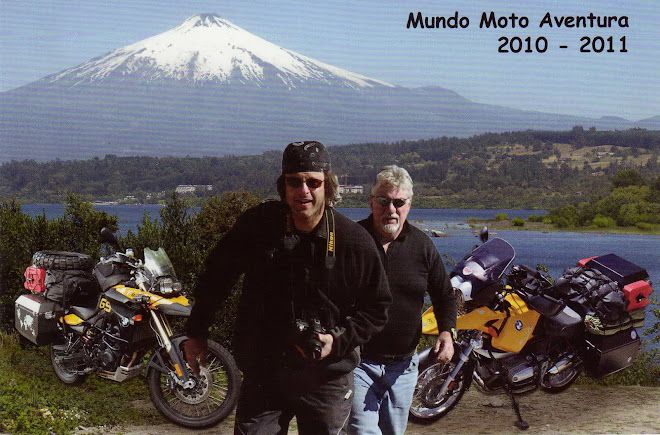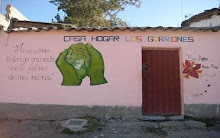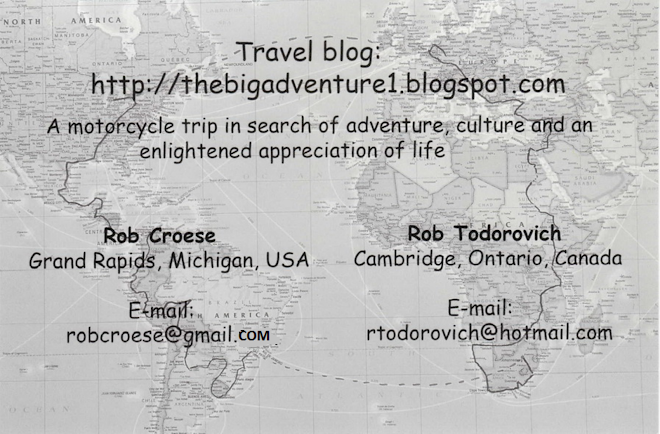RobT: The trip from Medellin to Cali (400 km - 260 miles) was supposed to take about 6 hours. We got directions and found our way out of the city, also thanks to the (free) GPS map of Colombia. The mountain roads, as usual, were very twisty and perfect biker roads. We missed a left-hand turn somewhere and rode the old road to Cali through Riosucio. The road itself was very much a secondary mountain road with its "challenges" of shifting pavement, mudslides, people and traffic. The villages were incredible! A lot of precariously perched homes along the road, with steep drop-offs at the rear of the houses.. If only we could describe what were seeing! I'm sure RobC has seen a lot of this before and I had a small taste of it the last two times in South America, but its just another world.
A roadside refreshment stand. The bathroom was a trough in the side of the wall, totally exposed to the patrons at the tables within. I guess women are not expected to have bathroom needs.
Part of the road followed the mountain ridges with steep drop-offs to the left and to the right, with barely enough room to fit a house on either side without having some sort of stilt structure on the hill side. Wow! At one point, half of the two lane road on one of the ridges had broken off and slid down the mountain. There was yellow caution tape wrapped around sticks and boulders to indicate danger. You couldn't see the side of the mountain on either side due to the angle of the drop. Little unnerving. If only we could have taken a picture, but there was no place to stop safely. At either end of this there were houses perched on the side of the cliffs. You wonder how people live in these structures without fear of their home sliding down the hill with them inside.
Down in the valley, swollen rivers all but invaded the stilted homes.
We rode in and out of the clouds and light rain for a good portion of the day, but fortunately it was never cold, as the altitude always hovered around 5000 feet (1500 meters). When the clouds lifted, coffee plants could be seen terraced into the the mountain side in neat rows.
We came to a small village where children were waving us down and warned about danger, got around the corner and the entire road section of about 75 feet had dropped about 8 inches. The dropped edge was at a 45 degree angle to the road on either side yet semi-trucks and cars were driving on it. It was like riding down a large curb then back up again on the other side. No markings or warning signs, just the kids, about 10 years old, warning people. This would have been a HUGE night hazard, specially in the rain. Yikes!!
One of the "pueblos" that really stuck out was a place called Guática. It had what looked like a monastery at the far end as you drove on the ridge, whole village straddled the ridge, an incredibly picturesque place, with no place to stop for a picture/
The 200 km mountain road took 6 hours. The last 200 km through the Cauca Valley took 2 hours.
Out of the mountains and into the valley.
At a nice restaurant near Pereira, where the road from Bogota to Cali joined us, the owner had built a spectacular chapel on the property, all made of native woods by artisans. On Sundays the chapel is opened up to the locals for mass.
In Cali we met a nice fellow (Henry Martinez), the owner of a Texaco service station. RobC talked to him and subsequently Henry took us to a hotel away from the center of town. He and others warned us about staying in the center of town because of a high rate of delinquency and kidnapping of odd looking people that don't speak Spanish, like me.
RobC: This was the first time in Colombia that we did not feel safe, other than the constant warnings about getting our stuff stolen. Of course, the people have been through a lot during recent decades, and they know more than we do. But it still seems to us that the country is safe and people, including police and armed forces, look out for the well-being of its citizens and visitors.
Here`s a road video clip. It has been awhile since we included one.
http://www.youtube.com/watch?v=_qmKHUGSiNs
Friday, November 19, 2010
Subscribe to:
Post Comments (Atom)
















Odd looking people. Fitting. :)
ReplyDeleteThe former honorary Colombian Consul in St Louis and her husband are from Cali. They tell me that the Cali accent is very distinctive. Have you noticed that?
ReplyDeleteEnjoying your adventures vicariously...
Wow, my parents have been telling me about the heavy rains and all the damage these has been causing,but looking at the pictures is another thing.I hope you guys enjoy Pasto. Los pastuzos, so you know, are the people we colombians make jokes about..Habian dos pastuzitos y el uno le dice al otro...Their kindness and good heart is in a way celebrated by the rest of the country. Have fun and let us know about the volcanoe.
ReplyDeleteHi Dick,
ReplyDeleteYes, I did notice different dialect variations throughout Colombia, as well as in other countries. The Spanish of Colombia is considered to be quite neutral and easy to understand, but this time around i did run into some people that were not easy to understand. I found the Spanish of the city on Pasto to by quite nasal.
Glad you are enjoying the blog, which is turning out to be quite a lot of work.
Best,
Rob
Hola Adriana,
ReplyDeleteYes, I have known about the ethnic jokes about the pastuzos, which are about the same as the gallego jokes. The people of Pasto were helpful and treated us like celebrities.
We did not see the volcano because of the clouds, but we did get to see the Santuarion de Las Lajas in Ipiales - impressive.
It continues to rain in the afternoons, even now that we are in Ecuador.
Abrazos,
Robc